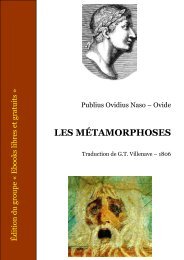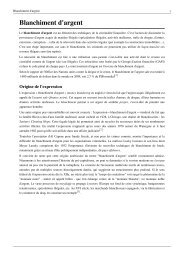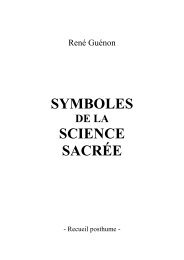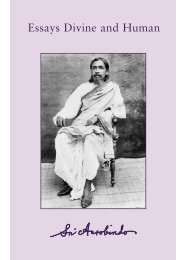- Page 1 and 2:
The Secret of the Veda
- Page 3:
The Secret of the Veda with Selecte
- Page 7:
Sri Aurobindo in Pondicherry
- Page 10 and 11:
CONTENTS XII The Herds of the Dawn
- Page 12 and 13:
CONTENTS Hymns to Agni Agni, the Di
- Page 15 and 16:
Chapter I The Problem and Its Solut
- Page 17 and 18:
The Problem and Its Solution 5 reve
- Page 19 and 20:
The Problem and Its Solution 7 also
- Page 21 and 22:
The Problem and Its Solution 9 just
- Page 23 and 24:
A Retrospect of Vedic Theory 11 reg
- Page 25 and 26:
A Retrospect of Vedic Theory 13 by
- Page 27 and 28:
A Retrospect of Vedic Theory 15 sen
- Page 29 and 30:
A Retrospect of Vedic Theory 17 eve
- Page 31 and 32:
A Retrospect of Vedic Theory 19 hel
- Page 33 and 34:
A Retrospect of Vedic Theory 21 ren
- Page 35 and 36:
A Retrospect of Vedic Theory 23 the
- Page 37 and 38:
Modern Theories 25 The modern theor
- Page 39 and 40:
Modern Theories 27 Nor is it a cert
- Page 41 and 42:
Modern Theories 29 an image of the
- Page 43 and 44:
Modern Theories 31 can throw light
- Page 45 and 46:
Modern Theories 33 universal Nature
- Page 47 and 48:
The Foundations of the Psychologica
- Page 49 and 50:
The Foundations of the Psychologica
- Page 51 and 52:
The Foundations of the Psychologica
- Page 53 and 54: The Foundations of the Psychologica
- Page 55 and 56: The Foundations of the Psychologica
- Page 57 and 58: The Foundations of the Psychologica
- Page 59 and 60: The Foundations of the Psychologica
- Page 61 and 62: The Philological Method of the Veda
- Page 63 and 64: The Philological Method of the Veda
- Page 65 and 66: The Philological Method of the Veda
- Page 67 and 68: The Philological Method of the Veda
- Page 69 and 70: The Philological Method of the Veda
- Page 71 and 72: Agni and the Truth 59 be necessary.
- Page 73 and 74: Agni and the Truth 61 we find the s
- Page 75 and 76: Agni and the Truth 63 satya and r.t
- Page 77 and 78: Agni and the Truth 65 state into an
- Page 79 and 80: Agni and the Truth 67 become immort
- Page 81 and 82: Agni and the Truth 69 one has and i
- Page 83 and 84: Varuna-Mitra and the Truth 71 power
- Page 85 and 86: Varuna-Mitra and the Truth 73 mind,
- Page 87 and 88: Varuna-Mitra and the Truth 75 indee
- Page 89 and 90: Varuna-Mitra and the Truth 77 Worki
- Page 91 and 92: Varuna-Mitra and the Truth 79 We se
- Page 93 and 94: The Ashwins — Indra — the Vishw
- Page 95 and 96: The Ashwins — Indra — the Vishw
- Page 97 and 98: The Ashwins — Indra — the Vishw
- Page 99 and 100: The Ashwins — Indra — the Vishw
- Page 101 and 102: The Ashwins — Indra — the Vishw
- Page 103: Chapter IX Saraswati and Her Consor
- Page 107 and 108: Saraswati and Her Consorts 95 “Ma
- Page 109 and 110: Saraswati and Her Consorts 97 bring
- Page 111 and 112: Saraswati and Her Consorts 99 the s
- Page 113 and 114: The Image of the Oceans and the Riv
- Page 115 and 116: The Image of the Oceans and the Riv
- Page 117 and 118: The Image of the Oceans and the Riv
- Page 119 and 120: The Image of the Oceans and the Riv
- Page 121 and 122: Chapter XI The Seven Rivers THE VED
- Page 123 and 124: The Seven Rivers 111 “May those d
- Page 125 and 126: The Seven Rivers 113 construction u
- Page 127 and 128: The Seven Rivers 115 13. Apā ˙m g
- Page 129 and 130: The Seven Rivers 117 increases by k
- Page 131 and 132: The Seven Rivers 119 the own or pro
- Page 133 and 134: The Seven Rivers 121 lord and lover
- Page 135 and 136: Chapter XII The Herds of the Dawn T
- Page 137 and 138: The Herds of the Dawn 125 of Helios
- Page 139 and 140: The Herds of the Dawn 127 gāva us.
- Page 141 and 142: The Herds of the Dawn 129 is only i
- Page 143 and 144: Chapter XIII Dawn and the Truth USH
- Page 145 and 146: Dawn and the Truth 133 devī devebh
- Page 147 and 148: Dawn and the Truth 135 comes divine
- Page 149 and 150: Dawn and the Truth 137 us from the
- Page 151 and 152: The Cow and the Angiras Legend 139
- Page 153 and 154: The Cow and the Angiras Legend 141
- Page 155 and 156:
The Cow and the Angiras Legend 143
- Page 157 and 158:
The Cow and the Angiras Legend 145
- Page 159 and 160:
The Cow and the Angiras Legend 147
- Page 161 and 162:
Chapter XV The Lost Sun and the Los
- Page 163 and 164:
The Lost Sun and the Lost Cows 151
- Page 165 and 166:
The Lost Sun and the Lost Cows 153
- Page 167 and 168:
The Lost Sun and the Lost Cows 155
- Page 169 and 170:
The Lost Sun and the Lost Cows 157
- Page 171 and 172:
Chapter XVI The Angiras Rishis THE
- Page 173 and 174:
The Angiras Rishis 161 In the Veda
- Page 175 and 176:
The Angiras Rishis 163 navagvo nu d
- Page 177 and 178:
The Angiras Rishis 165 as himself t
- Page 179 and 180:
The Angiras Rishis 167 in the sacri
- Page 181 and 182:
The Angiras Rishis 169 truth-thinki
- Page 183 and 184:
The Angiras Rishis 171 illumined (a
- Page 185 and 186:
Chapter XVII The Seven-Headed Thoug
- Page 187 and 188:
The Seven-Headed Thought, Swar and
- Page 189 and 190:
The Seven-Headed Thought, Swar and
- Page 191 and 192:
The Seven-Headed Thought, Swar and
- Page 193 and 194:
The Seven-Headed Thought, Swar and
- Page 195 and 196:
The Seven-Headed Thought, Swar and
- Page 197 and 198:
The Seven-Headed Thought, Swar and
- Page 199 and 200:
Chapter XVIII The Human Fathers THE
- Page 201 and 202:
The Human Fathers 189 Guest that lo
- Page 203 and 204:
The Human Fathers 191 and a great l
- Page 205 and 206:
The Human Fathers 193 children, sla
- Page 207 and 208:
The Human Fathers 195 thatwasplaced
- Page 209 and 210:
The Human Fathers 197 the gods (dev
- Page 211 and 212:
Chapter XIX The Victory of the Fath
- Page 213 and 214:
The Victory of the Fathers 201 all
- Page 215 and 216:
The Victory of the Fathers 203 Trut
- Page 217 and 218:
The Victory of the Fathers 205 fema
- Page 219 and 220:
The Victory of the Fathers 207 the
- Page 221 and 222:
The Victory of the Fathers 209 (or,
- Page 223 and 224:
Chapter XX The Hound of Heaven THER
- Page 225 and 226:
The Hound of Heaven 213 as is indee
- Page 227 and 228:
The Hound of Heaven 215 which goes
- Page 229 and 230:
The Hound of Heaven 217 perfectly s
- Page 231 and 232:
The Hound of Heaven 219 pure, had s
- Page 233 and 234:
The Hound of Heaven 221 which finds
- Page 235 and 236:
Chapter XXI The Sons of Darkness WE
- Page 237 and 238:
The Sons of Darkness 225 the Darkne
- Page 239 and 240:
The Sons of Darkness 227 grasp the
- Page 241 and 242:
The Sons of Darkness 229 shining hu
- Page 243 and 244:
The Sons of Darkness 231 the hymn i
- Page 245 and 246:
The Conquest over the Dasyus 233 of
- Page 247 and 248:
The Conquest over the Dasyus 235 th
- Page 249 and 250:
The Conquest over the Dasyus 237 wo
- Page 251 and 252:
The Conquest over the Dasyus 239 ma
- Page 253 and 254:
Chapter XXIII Summary of Conclusion
- Page 255 and 256:
Summary of Conclusions 243 The prin
- Page 257 and 258:
Summary of Conclusions 245 existenc
- Page 259:
Summary of Conclusions 247 numerous
- Page 263:
Author’s Note These translations
- Page 266 and 267:
254 Selected Hymns 4. Let them make
- Page 268 and 269:
256 Selected Hymns Agastya accepts
- Page 270 and 271:
258 Selected Hymns 5. And may the R
- Page 272 and 273:
260 Selected Hymns 8. “Drinking o
- Page 274 and 275:
262 Selected Hymns rays or damming
- Page 276 and 277:
264 Selected Hymns a climbing upwar
- Page 278 and 279:
III Indra and the Thought-Forces Ri
- Page 280 and 281:
268 Selected Hymns 6. Do thou, O In
- Page 282 and 283:
270 Selected Hymns There has been w
- Page 284 and 285:
272 Selected Hymns that travel thro
- Page 286 and 287:
274 Selected Hymns gradually, in th
- Page 288 and 289:
IV Agni, the Illumined Will RigVeda
- Page 290 and 291:
278 Selected Hymns enjoying, purify
- Page 292 and 293:
280 Selected Hymns presents itself
- Page 294 and 295:
282 Selected Hymns cosmic Powers ac
- Page 296 and 297:
284 Selected Hymns brilliant energi
- Page 298 and 299:
286 Selected Hymns 4. And thou reac
- Page 300 and 301:
288 Selected Hymns Vedic Rishis. Th
- Page 302 and 303:
290 Selected Hymns and sovereign Po
- Page 304 and 305:
292 Selected Hymns the intuitive re
- Page 306 and 307:
294 Selected Hymns 4. Dawn in her p
- Page 308 and 309:
296 Selected Hymns the dawn of the
- Page 310 and 311:
298 Selected Hymns and purity; he i
- Page 312 and 313:
300 Selected Hymns 5. All evils, O
- Page 314 and 315:
302 Selected Hymns described as hol
- Page 316 and 317:
304 Selected Hymns creative, it is
- Page 318 and 319:
VIII Vayu, the Master of the Life E
- Page 320 and 321:
308 Selected Hymns horns are infini
- Page 322 and 323:
310 Selected Hymns the nervous acti
- Page 324 and 325:
312 Selected Hymns Vayu, of Surya h
- Page 326 and 327:
314 Selected Hymns of the increase
- Page 328 and 329:
316 Selected Hymns 4. Brihaspati fi
- Page 330 and 331:
318 Selected Hymns separated terms
- Page 332 and 333:
320 Selected Hymns and formulated f
- Page 334 and 335:
322 Selected Hymns the vastness of
- Page 336 and 337:
324 Selected Hymns progress of the
- Page 338 and 339:
X The Ashwins, Lords of Bliss RigVe
- Page 340 and 341:
328 Selected Hymns COMMENTARY The h
- Page 342 and 343:
330 Selected Hymns is a double acti
- Page 344 and 345:
332 Selected Hymns full of the glor
- Page 346 and 347:
334 Selected Hymns progress they wo
- Page 348 and 349:
XI The Ribhus, Artisans of Immortal
- Page 350 and 351:
338 Selected Hymns as their own div
- Page 352 and 353:
340 Selected Hymns The third work o
- Page 354 and 355:
342 Selected Hymns Such are the Rib
- Page 356 and 357:
344 Selected Hymns 4. He whose thre
- Page 358 and 359:
346 Selected Hymns that the later c
- Page 360 and 361:
348 Selected Hymns In those three s
- Page 362 and 363:
350 Selected Hymns that high-placed
- Page 364 and 365:
352 Selected Hymns which is his; st
- Page 366 and 367:
354 Selected Hymns thou makest of o
- Page 368 and 369:
356 Selected Hymns some particular
- Page 370 and 371:
358 Selected Hymns radiant herds of
- Page 372 and 373:
360 Selected Hymns immortal state.
- Page 375 and 376:
Foreword TO TRANSLATE the Veda is t
- Page 377 and 378:
Foreword 365 and religion had repla
- Page 379 and 380:
Foreword 367 But how are we to brin
- Page 381 and 382:
Foreword 369 in the darkling cave o
- Page 383 and 384:
The Doctrine of the Mystics 371 and
- Page 385 and 386:
The Doctrine of the Mystics 373 of
- Page 387 and 388:
The Doctrine of the Mystics 375 fee
- Page 389 and 390:
The Doctrine of the Mystics 377 by
- Page 391 and 392:
The Doctrine of the Mystics 379 God
- Page 393 and 394:
The Doctrine of the Mystics 381 and
- Page 395 and 396:
The Doctrine of the Mystics 383 tha
- Page 397:
Hymns to Agni
- Page 400 and 401:
388 Hymns of the Atris in all its w
- Page 402 and 403:
390 Hymns of the Atris to the highe
- Page 404 and 405:
392 Hymns of the Atris The variety
- Page 406 and 407:
394 Hymns of the Atris 3. When he h
- Page 408 and 409:
396 Hymns of the Atris desirable, f
- Page 410 and 411:
398 Hymns of the Atris 2. Who is th
- Page 412 and 413:
400 Hymns of the Atris 10. May the
- Page 414 and 415:
402 Hymns of the Atris 2. O thou wh
- Page 416 and 417:
404 Hymns of the Atris av -pED Eptr
- Page 418 and 419:
406 Hymns of the Atris that belong
- Page 420 and 421:
408 Hymns of the Atris y-(vA ãdA k
- Page 422 and 423:
410 Hymns of the Atris UZm}dA Ev þ
- Page 424 and 425:
412 Hymns of the Atris 11. Swaha to
- Page 426 and 427:
414 Hymns of the Atris 2. He is tha
- Page 428 and 429:
416 Hymns of the Atris evA aE`nmj;
- Page 430 and 431:
418 Hymns of the Atris 2. Wheresoev
- Page 432 and 433:
420 Hymns of the Atris aA y-t sEprA
- Page 434 and 435:
422 Hymns of the Atris (vAm`n mAn;
- Page 436 and 437:
The Ninth Hymn to Agni DIVINE WILL
- Page 438 and 439:
426 Hymns of the Atris t\ no a`n aB
- Page 440 and 441:
428 Hymns of the Atris (v\ no a`n e
- Page 442 and 443:
The Eleventh Hymn to Agni AHYMNTOTH
- Page 444 and 445:
432 Hymns of the Atris 6. O Flame,
- Page 446 and 447:
434 Hymns of the Atris t\ EcEk(v tE
- Page 448 and 449:
The Thirteenth Hymn to Agni A HYMN
- Page 450 and 451:
The Fourteenth Hymn to Agni A HYMN
- Page 452 and 453:
The Fifteenth Hymn to Agni A HYMN O
- Page 454 and 455:
The Sixteenth Hymn to Agni A HYMN T
- Page 456 and 457:
The Seventeenth Hymn to Agni A HYMN
- Page 458 and 459:
The Eighteenth Hymn to Agni A HYMN
- Page 460 and 461:
448 Hymns of the Atris 5. They who
- Page 462 and 463:
450 Hymns of the Atris 3. Men who a
- Page 464 and 465:
452 Hymns of the Atris i(TA yTA t U
- Page 466 and 467:
454 Hymns of the Atris dv\ vo dvy>y
- Page 468 and 469:
456 Hymns of the Atris 3. Mortals,
- Page 470 and 471:
458 Hymns of the Atris clear their
- Page 472 and 473:
The Twenty-Fifth Hymn to Agni A HYM
- Page 474 and 475:
462 Hymns of the Atris 7. That whic
- Page 476 and 477:
464 Hymns of the Atris a`n Ev[vEBrA
- Page 478 and 479:
The Twenty-Seventh Hymn to Agni A H
- Page 480 and 481:
468 Hymns of the Atris yo m iEt þv
- Page 482 and 483:
470 Hymns of the Atris 3. O Flame,
- Page 485 and 486:
The Guardians of the Light SURYA, L
- Page 487 and 488:
The Guardians of the Light 475 and
- Page 489 and 490:
The Guardians of the Light 477 of t
- Page 491 and 492:
The Guardians of the Light 479 moun
- Page 493 and 494:
The Guardians of the Light 481 worl
- Page 495 and 496:
The Guardians of the Light 483 of o
- Page 497 and 498:
The Guardians of the Light 485 More
- Page 499 and 500:
The Guardians of the Light 487 in f
- Page 501 and 502:
The Guardians of the Light 489 SAVI
- Page 503 and 504:
The Guardians of the Light 491 Push
- Page 505 and 506:
The Guardians of the Light 493 sacr
- Page 507 and 508:
The Guardians of the Light 495 harm
- Page 509 and 510:
The Guardians of the Light 497 Stil
- Page 511 and 512:
The Guardians of the Light 499 Bhag
- Page 513 and 514:
The Guardians of the Light 501 and
- Page 515 and 516:
The Guardians of the Light 503 hors
- Page 517 and 518:
The Guardians of the Light 505 be g
- Page 519 and 520:
The Guardians of the Light 507 man
- Page 521 and 522:
The Guardians of the Light 509 many
- Page 523 and 524:
The Guardians of the Light 511 righ
- Page 525 and 526:
The Guardians of the Light 513 the
- Page 527 and 528:
The Guardians of the Light 515 Mast
- Page 529 and 530:
The Guardians of the Light 517 the
- Page 531 and 532:
Hymns to the Lords of Light 519 and
- Page 533 and 534:
Hymns to the Lords of Light 521 Ehr
- Page 535 and 536:
Hymns to the Lords of Light 523 t-y
- Page 537 and 538:
Hymns to the Lords of Light 525 7.
- Page 539 and 540:
Hymns to the Lords of Light 527 2.
- Page 541 and 542:
The Fourth Hymn to Mitra-Varuna THE
- Page 543 and 544:
The Fifth Hymn to Mitra-Varuna THE
- Page 545 and 546:
Hymns to the Lords of Light 533 6.
- Page 547 and 548:
Hymns to the Lords of Light 535 2.
- Page 549 and 550:
Hymns to the Lords of Light 537 3.
- Page 551 and 552:
Hymns to the Lords of Light 539 2.
- Page 553 and 554:
Hymns to the Lords of Light 541 3.
- Page 555 and 556:
The Eleventh Hymn to Mitra-Varuna A
- Page 557 and 558:
Hymns to the Lords of Light 545 the
- Page 559 and 560:
Hymns to the Lords of Light 547 tho
- Page 561 and 562:
The First Hymn to the Dawn [The Ris
- Page 563 and 564:
Hymns to the Lords of Light 551 eq;
- Page 565 and 566:
The Second Hymn to the Dawn [The Ri
- Page 567 and 568:
A Hymn to Savitri [The Rishi hymns
- Page 569:
Part Four Other Hymns
- Page 572 and 573:
560 Other Hymns found all our creat
- Page 574 and 575:
A Hymn of the Thought-Gods The shin
- Page 576 and 577:
564 Other Hymns a seer and a king.
- Page 578 and 579:
566 Other Hymns 3. Breaking into li
- Page 580 and 581:
The Vedic Fire RigVedaI.94and97 I i
- Page 582 and 583:
570 Other Hymns pvo dvA Bvt; s; vto
- Page 584 and 585:
572 Other Hymns forcefulness, by th
- Page 586 and 587:
A Vedic Hymn to the Fire A HYMN OF
- Page 588 and 589:
Parashara’s Hymns to the Lord of
- Page 590 and 591:
578 Other Hymns ajo n "A\ dADAr pET
- Page 592 and 593:
580 Other Hymns 4 rEyn Ec/A sro n s
- Page 594 and 595:
582 Other Hymns He is as if our rap
- Page 596 and 597:
584 Other Hymns 7 up þ Ej và; ftF
- Page 598 and 599:
586 Other Hymns One who goes immedi
- Page 600 and 601:
588 Other Hymns -vA@yo Edv aA sØ y
- Page 602 and 603:
590 Other Hymns evenly over the mou
- Page 605 and 606:
Interpretation of the Veda MR. AURO
- Page 607 and 608:
Interpretation of the Veda 595 in s
- Page 609:
Note on the Texts
- Page 612 and 613:
600 The Secret of the Veda Sri Auro
- Page 614 and 615:
602 The Secret of the Veda sixth ve
- Page 616:
604 The Secret of the Veda and tran
















